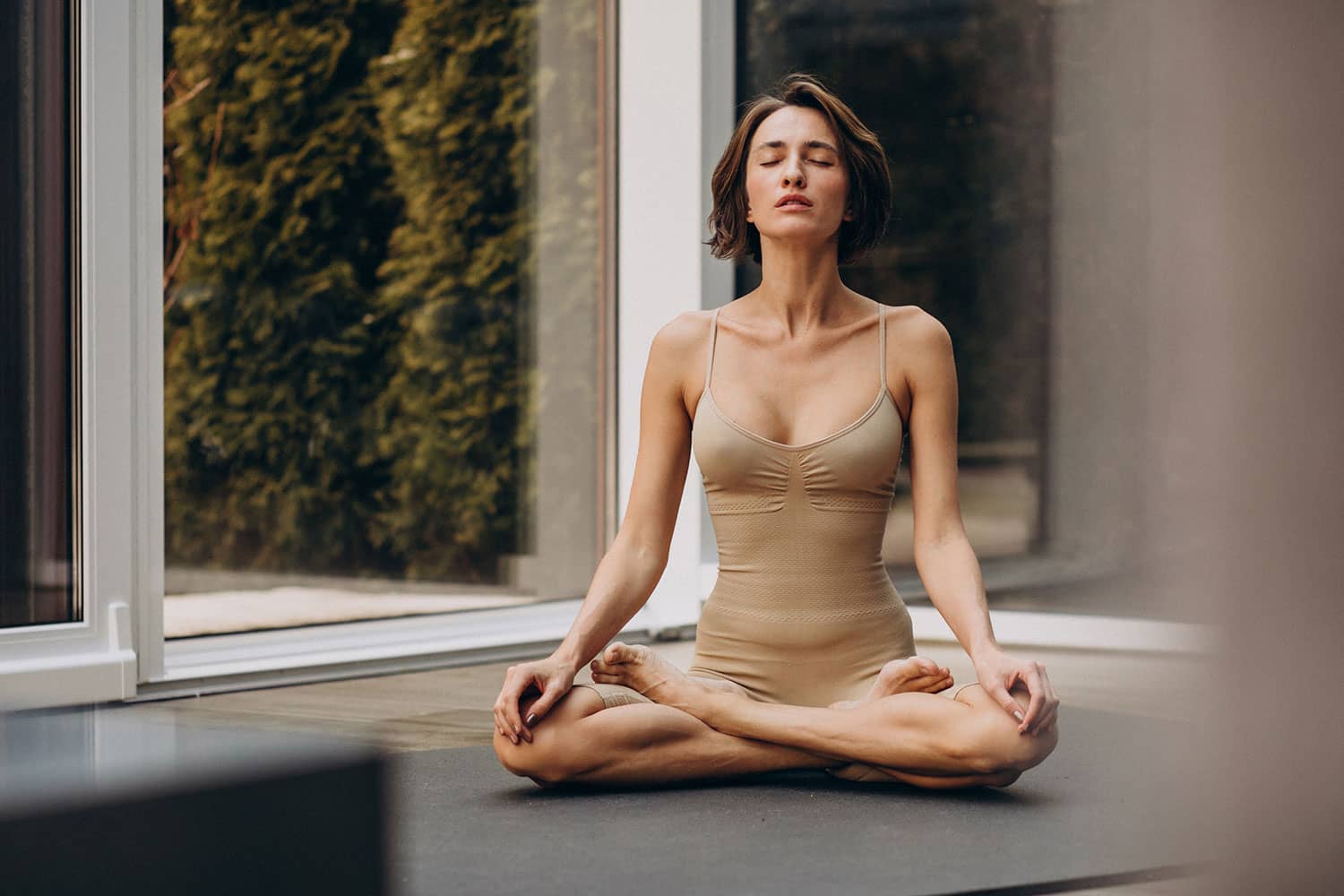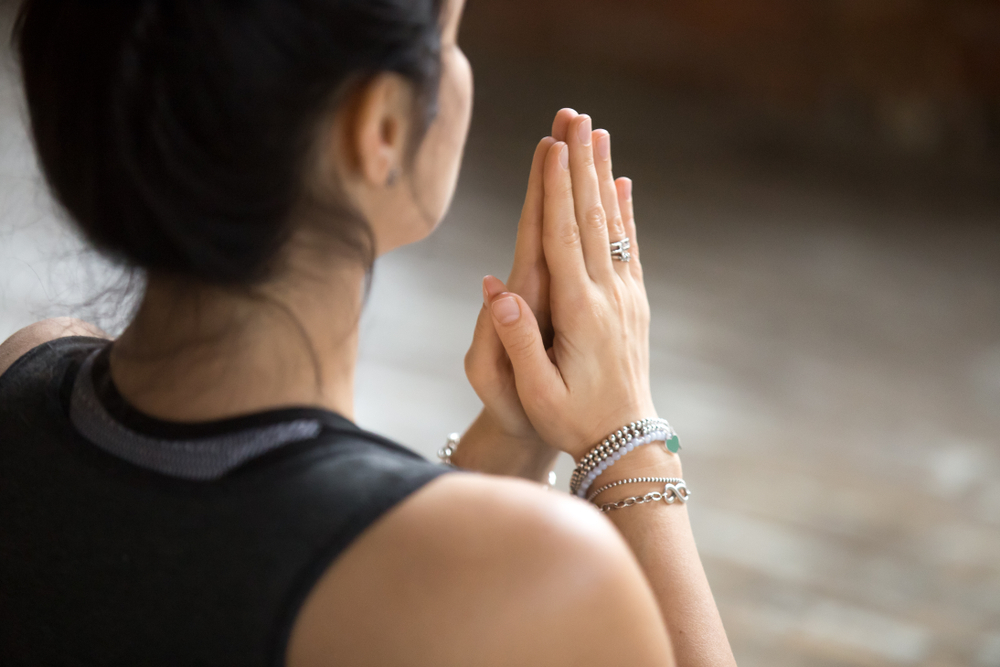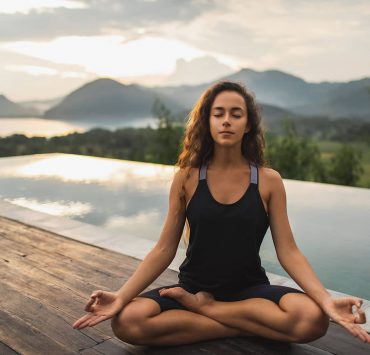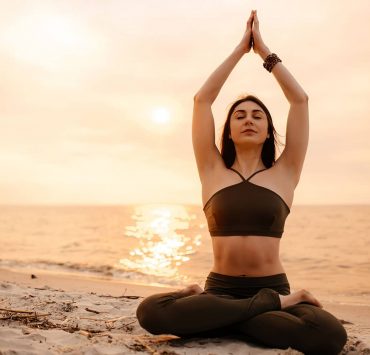
Former nutrition specialist Alexandra Mackenzie knows what it means to…
You may have heard the Sanskrit term Brahmacharya mentioned during yoga class or in a yoga philosophy book. What does this ancient term actually mean?
Brahmacharya refers to the use of energy. In today’s world where people are rushing from one task to the next, it is important to pause and consider how you are using your energy.
Take a moment to reflect if you are using your energy to cultivate a sense of peace versus a sense of stress. Learn about some small steps you can take each day to refocus your energy and live a life of moderation to find peace and happiness.
What is Brahmacharya?

Brahmacharya is an important part of yoga philosophy. In fact, Brahmacharya is part of Pantajali’s Sutras as one of the 5 Yamas on the 8-limb path. The Yamas and Niyamas are important life guidelines. They help us in developing relationships with the internal and the external.
Today, Brahmacharya is a practice of moderation. In a society that values money and success, and has super-size options at every fast food restaurant, moderation can be hard.
Brahmacharya teaches us the process of self-regulation. It teaches how to use energy to bring about internal peace and happiness instead of overindulging now and feeling bad and depressed later. Those who put in the hard work to practice moderation every day will be able to find greater joys in day-to-day life.
As stated by Emma Newlyn of Eckhart Yoga, “Brahmacharya also evokes a sense of directing our energy away from external desires … and instead, towards finding peace and happiness within ourselves.”
By developing a practice of being aware of how we direct our energy each day, we can figure out ways to live a life of moderation. This can lead us to become the happiest version of ourselves.
The 8-Limb Path
The 8-limb path is a journey that lasts a lifetime. Each limb helps practitioners to learn how to foster a relationship with both the external and the internal. The ultimate goal is Samadhi. Samadhi occurs when the individual is united and one with the divine/ultimate teacher/universal consciousness. As great as Samadhi sounds, it cannot happen overnight. It takes consistent practice and work through each limb to reach this final state of peace.
The Yamas

The Yamas are principles that help practitioners interact with the external components of the world. There are 5 Yamas.
Ahimsa: Ahimsa is taking the path of least harm or non-violence. This Yama helps us to become aware of how we are treating ourselves and others. It encourages the practitioner to be compassionate to others, ourselves, and nature.
Satya: Satya is truthfulness. Seeking the truth can be difficult. We often tell ourselves lies that end up making us miserable. Emma Newlyn of Ekhart Yoga teaches that Satya can be applied to many areas of our lives. Truthfulness should be practiced toward ourselves, in our relationships, and on the yoga mat.
Asteya: Asteya means non-stealing. When we think of stealing, we often think of shoplifting or robbery. In reality, stealing is a practice many of us do without even knowing it. As Deborah Adele puts it in her book The Yamas & Niyamas, we steal from ourselves when we try to be something that we are not. Working a job that doesn’t bring you joy? Not taking the time to do hobbies that you love? These are both ways that many people “steal” from themselves every day.
Aparigraha: Aparigraha is the practice of non-grasping. It is the idea of being happy with what you have and not always wanting more. In western culture, the concept of keeping up with the Jones’ leads to many people grasping for things they want and think they need. Whether it’s a new house, a new job, or more money, this practice of grasping is destructive. Aparigraha teaches us to be satisfied with the here and now and that we don’t need more to be happy.
Brahmacharya: As mentioned above, Brahmacharya is an awareness of our use of energy. Emma Newlyn of Eckahrt Yoga states it perfectly: “Right now there seems to be an overemphasis on how ‘busy’ we should all be – that busy is better – and that if you’re not busy, there’s something wrong.”
Instead of trying to fill days with mindless activities, what if you took the time to listen to your body and use your energy in a more positive, mindful way?
The Niyamas

While the Yamas focus on our relationship with the external, the Niyamas focus on our relationship with ourselves.
Saucha: Saucha means cleanliness. This Niyama can be taken literally and metaphorically. In a literal sense, examine the clutter that surrounds you. Take the time to clean up your house or office. In a metaphorical sense, notice if there is clutter in your mind. Are there thoughts running through your head that you can let go of?
Santosha: Santosha is the practice of contentment. This is a practice that works in all areas of life. As you move through your day, find areas at work, home, in your relationships, and in your yoga practice that you are content with. The more you seek out contentment, the more positivity and peace you will feel.
Tapas: Tapas is the practice of self-discipline. This practice looks different for everyone. For one person it could be finding time to exercise every day. For another, it could be taking the time to cook a healthy meal each evening. Through commitment and positivity, the practice of tapas can be very rewarding.
Svadhyaya: Svadhyaya means self-study. This is the process of reflection and introspection. Take time to clear your mind through methods like yoga, meditation, or pranayama. Look inside to study yourself. You will be surprised at what you find and learn during this process!
Ishvara Pranidhana: This is the practice of surrendering to wisdom. Ishvara Pranidhana can look like a spiritual practice for some. For others, it can be something like painting, running, or cooking. According to Shiva Rea “the whole mandala of life is the realm of Ishvara Pranidhana.”
Pratyahara
This limb emphasizes refocusing the senses from the internal to the external. This can be a difficult practice as there are so much external stimuli that we are bombarded with each day. This practice takes time and commitment.
Pranayama

The next limb of yoga is pranayama. Prana is the life force inside everyone. It can be liberated through different breath practices.
Dharana
Dharana means concentration. According to Mohan-ji, this is perhaps the most important limb of the 8-limbs. He says this because he believes a level of concentration and focus are needed before embarking on the journey through the other limbs of yoga.
Dhyana
This is the practice of meditation.
Asana

In the practice of physical yoga, we think of asana as a pose. In Sanskrit, this word means a “seat”. The goal of this limb is to find the delicate balance of effort and ease. This can be done in the physical practice of yoga but can also be practiced in life.
Samahdi
Samadhi is reached when the individual is united with the divine/ultimate teacher/universal consciousness. According to the Pilgrimage Through Patanjali’s Yoga Sutras Guidebook for Yoga Teachers, “Samadhi is the culmination of the totality of it all, and leads us to the complete understanding of Svarupa (Atman)”.
Back to Brahmacharya!
While Brahmacharya can seem like a small part of the larger 8-limb path, it is crucial. If you are misusing your energy, how can you ever reach a state of meditation, concentration, or true self-reflection? Having a reverence for your energy will help you create the space you need to seek truthfulness.
Brahmacharya: A History

Brahmacharya goes beyond modern day yoga and has been practiced in the Hindu religion for years. In Sanskrit, the word means “conduct consistent with Brahman”. The idea of restraint is seen in ancient Indian practitioners through things like celibacy, certain ways of eating, and practicing meditation.
While today it may seem unrealistic to lead such a restrictive life, there are ways we can use our energy in a positive way to create a sense of peace.
What You Will Need to Begin Practicing Brahmacharya

- A positive attitude
- An open mind
- A willingness to learn
- Journal
- Yamas & Niyamas: Exploring Yoga’s Ethical Practice by Deborah Adele. This book gives readers practical ways to practice the Yamas and Niyamas in daily life.
Step-by-Step Instructions for Practicing Brahmacharya in Everyday Life
Whether you have a shopping habit, overindulge in alcohol, or spend hours a day watching Netflix, everyone has an opportunity to take a step back and find areas of their life that need moderation. Listed below are some common places where the practice of Brahmacharya can be very helpful. By moderating your energy in these areas, you will begin to embark down the 8-limb path to a better, happier you!
Moderation in Eating

What we eat greatly affects how we think, feel, and act. If you are using your energy to eat fast food and sweets all the time, you will most likely feel sluggish and can experience illnesses like diabetes or heart issues.
Try using your energy to focus on healthy foods. Make it a goal to cook dinner at least 4 times each week. If that feels like too much, start with once or twice a week. Research nutritious recipes and talk with a doctor or nutritionist about food that you should be eating. Over time, you will notice how eating in a healthy way will give you more energy!
Moderation in Drinking

There is nothing wrong with a glass of wine here and there but when you find yourself frequently overindulging with alcohol, it can become a problem. Not only can it negatively affect your health, but it can also cause you to feel anxious, depressed, and sick.
Practice Brahmacharya by moderating your alcohol intake. Set a limit for yourself each week and stick to it! Another great way to start the moderation practice is to take on a dry month. For example, participate in dry January and abstain from alcohol all month.
Use of Energy in Extracurricular Activities

If you are being honest, a lot of your day is probably spent running around doing activities that stress you out. Maybe you feel like you have to exercise every day, so you force yourself to go to the gym even when you don’t want to. This is an area where we can practice Brahmacharya. First, listen to your body. If your body is telling you to go to the gym, go to the gym. If your body is telling you to relax and read, relax and read! Self-reflect on your daily extracurricular activities and figure out which are making you happy and which are unnecessarily taking up too much of your energy.
Moderation of Emotions

This one is key! Think about how many hours of your life you spend worrying, feeling anxious, or being angry. What if each minute you had a negative emotion, you flipped your perspective and turned your feelings into those of hope and positivity? By moderating our responses and focusing on the here and now, we will spend much less time wasting our energy on negative emotions.
Moderation of Work

Easier said than done when so many people work from home these days. It is crucial, especially if you work from home, to create boundaries between work, family time, and time to relax. Work can easily bleed into other areas of life and it is important to shift your energy so that overworking does not happen. By creating separate work time and downtime, you will find yourself having more energy and becoming more productive at work. Sit down and make a schedule. Give yourself and start and stop time for work each day. Take a break from work when you sit down for meals. Mindfully enjoying breakfast, lunch, and dinner is a great way to slow down and refocus energy. Schedule activities you like to do whether that’s playing with your kids or taking a yoga class.

As you make these changes to refocus your energy, take the time for self-reflection. Grab a journal and take the time each evening to write about your practice of Brahmacharya. Note any time you were able to evaluate your use of energy and change it in a more positive direction. This will give you the chance to see which practices are working and which aren’t
Brahmacharya: A Practice for All!
Brahmacharya is a great practice and the best part is, you can start right here, right now. This Yama is a lifelong journey, so don’t be disappointed if you don’t feel inner peace overnight. The more areas of your life where you can cultivate the practice of Brahmacharya, the more you will be able to feel that sense of peace and joy. The key is to start small. Pick a few areas of your life where you could use a refocus of your energy. Work on those areas, self-reflect, and notice positive changes start to occur in your life.
What's Your Reaction?
Former nutrition specialist Alexandra Mackenzie knows what it means to support the body and mind through food. She’s passionate about sharing her wealth of knowledge with anyone willing to listen.














